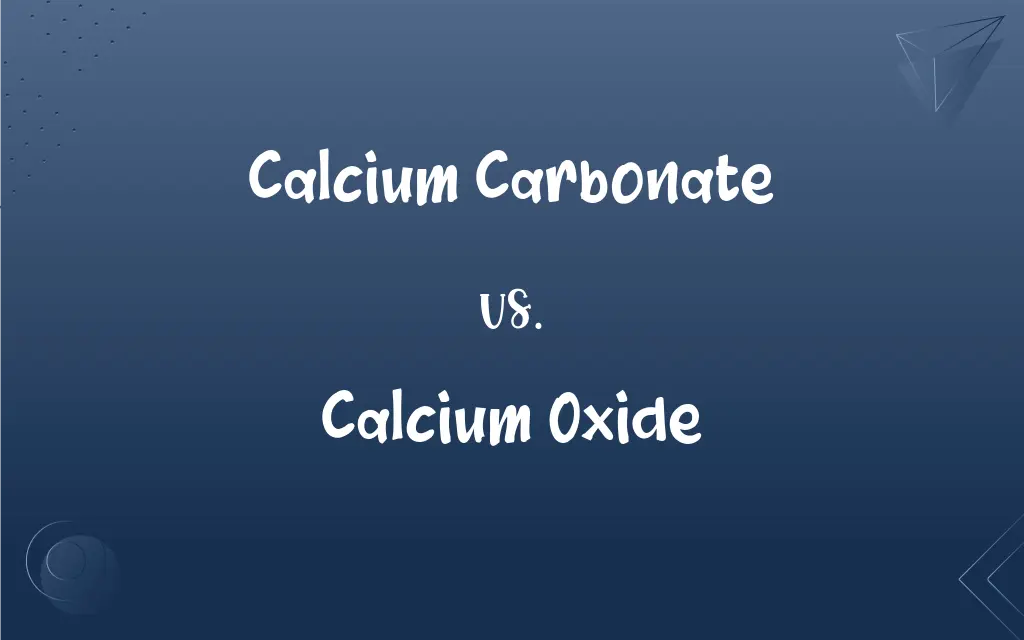Calcium Carbonate vs. Calcium Oxide: What's the Difference?
Edited by Aimie Carlson || By Janet White || Published on July 24, 2024
Calcium carbonate (CaCO3) is a common compound found in rocks and shells, while calcium oxide (CaO), also known as quicklime, is a highly reactive compound used in various industrial processes.

Key Differences
Calcium carbonate consists of calcium, carbon, and oxygen atoms, forming a stable compound commonly found in nature. Calcium oxide, on the other hand, is composed of calcium and oxygen atoms, forming a more reactive compound.
Calcium carbonate is a white, insoluble powder or crystalline solid, often used as a filler or extender in products. Calcium oxide is a white or grayish-white solid that reacts vigorously with water to form calcium hydroxide.
Calcium carbonate is widely used in the construction industry, as a dietary supplement, and in the production of lime and cement. Calcium oxide is used in the steel industry, water treatment, and as a desiccant.
Calcium carbonate is relatively stable and non-reactive under normal conditions. Calcium oxide, however, is highly reactive, especially with water, where it releases a significant amount of heat.
Calcium carbonate is a major component of marine and terrestrial ecosystems and plays a crucial role in the carbon cycle. Calcium oxide, due to its reactivity, must be handled with care to avoid environmental and health hazards.
ADVERTISEMENT
Comparison Chart
Chemical Composition
Calcium, carbon, and oxygen (CaCO3)
Calcium and oxygen (CaO)
Physical Properties
White, insoluble powder or crystalline solid
White or grayish-white, highly reactive solid
Applications
Construction, dietary supplement, lime production
Steel industry, water treatment, desiccant
Reactivity
Relatively stable and non-reactive
Highly reactive, especially with water
Environmental Impact
Major component of ecosystems, carbon cycle
Must be handled carefully due to reactivity
ADVERTISEMENT
Calcium Carbonate and Calcium Oxide Definitions
Calcium Carbonate
A primary constituent of limestone.
The cliffs are composed mainly of calcium carbonate.
Calcium Oxide
Used in water purification.
Calcium oxide helps remove impurities from water.
Calcium Carbonate
A source of dietary calcium.
Calcium carbonate supplements can help prevent osteoporosis.
Calcium Oxide
Another name for calcium oxide.
Quicklime is used in the production of steel.
Calcium Carbonate
Contributes to water hardness.
The high calcium carbonate content makes the water hard.
Calcium Oxide
Used in high-temperature applications.
Calcium oxide is a component of refractory bricks.
Calcium Carbonate
Used to neutralize stomach acid.
She took a calcium carbonate tablet for her indigestion.
Calcium Oxide
Used to absorb moisture.
Calcium oxide is an effective desiccant for keeping materials dry.
Calcium Carbonate
Used as a filler in paints.
Calcium carbonate provides opacity and bulk to paint.
Calcium Oxide
Used to neutralize acids.
Calcium oxide is added to acidic soil to raise its pH.
FAQs
How are calcium carbonate and calcium oxide used in industry?
Calcium carbonate is used in construction, as a filler in products, and in the production of lime and cement. Calcium oxide is used in the steel industry, water treatment, and as a desiccant.
What is the difference in reactivity between calcium carbonate and calcium oxide?
Calcium carbonate is relatively stable and non-reactive, while calcium oxide is highly reactive, especially with water.
What is calcium carbonate?
Calcium carbonate is a chemical compound with the formula CaCO3, commonly found in rocks and shells.
How is calcium carbonate used as a dietary supplement?
Calcium carbonate is used as a dietary supplement to provide calcium, which is essential for bone health and other physiological functions.
Can calcium carbonate be converted into calcium oxide?
Yes, calcium carbonate can be converted into calcium oxide through a process called calcination, where it is heated to high temperatures in the absence of air.
How does calcium carbonate contribute to water hardness?
Calcium carbonate contributes to water hardness by increasing the concentration of calcium ions in the water.
What is the role of calcium oxide in water treatment?
Calcium oxide is used in water treatment to remove impurities and adjust the pH of water.
What are the health risks associated with calcium oxide?
Calcium oxide can cause burns, respiratory issues, and eye irritation upon contact, and should be handled with caution.
What is calcium oxide?
Calcium oxide, also known as quicklime, is a highly reactive chemical compound with the formula CaO.
What are the environmental impacts of calcium carbonate and calcium oxide?
Calcium carbonate is a major component of ecosystems and plays a role in the carbon cycle. Calcium oxide, due to its reactivity, must be handled with care to avoid environmental and health hazards.
What safety precautions are necessary when handling calcium oxide?
When handling calcium oxide, it is important to wear protective gear, avoid contact with skin and eyes, and prevent exposure to moisture.
How is calcium oxide used as a neutralizing agent?
Calcium oxide is used as a neutralizing agent to raise the pH of acidic soils or industrial waste streams.
Can calcium carbonate be used as an antacid?
Yes, calcium carbonate is commonly used as an antacid to neutralize stomach acid and relieve heartburn and indigestion.
What are the physical properties of calcium carbonate?
Calcium carbonate is a white, insoluble powder or crystalline solid that is commonly found in nature.
How is calcium oxide used in the steel industry?
Calcium oxide is used in the steel industry as a flux to remove impurities and as a refractory material to line furnaces.
What are the health risks associated with calcium carbonate?
Calcium carbonate is generally safe when used as directed, but excessive intake can lead to hypercalcemia and kidney stones.
What are the physical properties of calcium oxide?
Calcium oxide is a white or grayish-white solid that is highly reactive and can react vigorously with water.
What is the significance of calcium carbonate in the carbon cycle?
Calcium carbonate plays a crucial role in the carbon cycle by acting as a carbon sink, storing carbon dioxide in the form of carbonate minerals.
How is calcium carbonate used in the construction industry?
Calcium carbonate is used in the construction industry as a building material, in cement production, and as an aggregate in concrete.
What is the role of calcium oxide as a desiccant?
Calcium oxide acts as a desiccant by absorbing moisture from the air, keeping materials dry.
About Author
Written by
Janet WhiteJanet White has been an esteemed writer and blogger for Difference Wiki. Holding a Master's degree in Science and Medical Journalism from the prestigious Boston University, she has consistently demonstrated her expertise and passion for her field. When she's not immersed in her work, Janet relishes her time exercising, delving into a good book, and cherishing moments with friends and family.
Edited by
Aimie CarlsonAimie Carlson, holding a master's degree in English literature, is a fervent English language enthusiast. She lends her writing talents to Difference Wiki, a prominent website that specializes in comparisons, offering readers insightful analyses that both captivate and inform.






































































